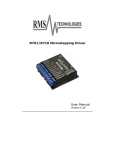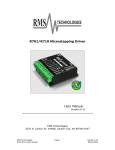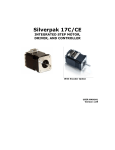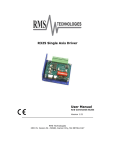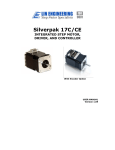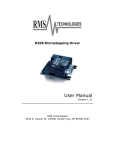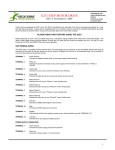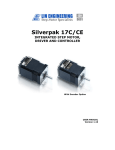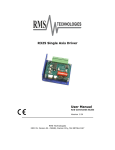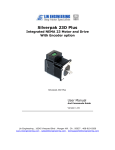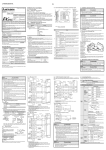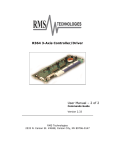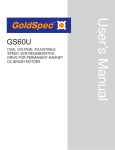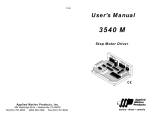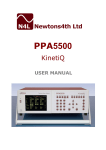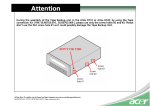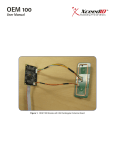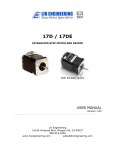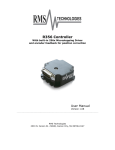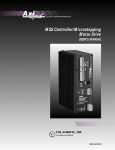Download R701/R710 Microstepping Driver User Manual
Transcript
R701/R710 Microstepping Driver User Manual Version 6.29 RMS Technologies 2533 N. Carson St. #4698, Carson City, NV 89706-0147 RMS Technologies R701/R710 User Manual Page 1 Version 6.29 04/24/2007 Thank you for purchasing the R701/R710 Driver. This product is warranted to be free of manufacturing defects for one year from the date of purchase. Technical Support By Telephone: 408-919-0200 (Mon.-Fri., 8:00 a.m.-5:00 p.m.) On the Web: www.linengineering.com Our technical support group is glad to work with you in answering your questions. If you cannot find the solution to your particular application, or, if for any reason you need additional technical assistance, please call technical support at 408-919-0200. PLEASE READ BEFORE USING Before you start, you must have a suitable step motor, a DC power supply suitable for the motor and a current resistor. The motor’s rated phase current must be between 1 Amps and 7 Amps, or between 0.3 Amps and 2 Amps for the low current range. The power supply voltage must be between 4 times and 20 times the motor’s rated voltage. The current set resistor may be a ¼ Watt, 5% part. Finally have a STEP and DIRECTION pulse source available. DISCLAIMER The information provided in this document is believed to be reliable. However, no responsibility is assumed for any possible inaccuracies or omissions. Specifications are subject to change without notice. RMS Technologies reserves the right to make changes without further notice to any products herein to improve reliability, function, or design. RMS Technologies does not assume any liability arising out of the application or use of any product or circuit described herein; neither does it convey any license under its patent rights, nor the rights of others. Special Symbols The “exclamation mark” indicates a WARNING and that this information could prevent injury, loss of property, or even death (in extreme cases). RMS Technologies R701/R710 User Manual Page 2 Version 6.29 04/24/2007 TABLE OF CONTENTS 1. FEATURES............................................................................. 4 R701........................................................................................................ 4 R710........................................................................................................ 4 Input Option Header ................................................................................................................ 4 Multiplier Option Header........................................................................................................ 5 Figure 1: R710 Input Option and Multiplier Header.......................................................... 5 2. ELECTRICAL SPECIFICATIONS.............................................. 5 3. OPERATING SPECIFICATIONS .............................................. 5 Operating Temperature .......................................................................................................... 5 Heatsinking.................................................................................................................................... 6 4. MECHANICAL SPECIFICATION .............................................. 6 Dimensions .................................................................................................................................... 6 5. PIN ASSIGNMENTS ............................................................... 7 6. CONNECTION SPECIFICATIONS............................................ 7 List of Parts ................................................................................................................................... 7 How to Connect ........................................................................................................................... 8 Table 2: Current (1 to 7 Amps)Resistor Values ................................................................. 9 Table 3: Current (0.3 to 2 Amps) Resistor Values ............................................................ 9 Figure 3: Connections Diagram ................................................................................................ 9 Resistor Values for the Opto Supply............................................................................. 10 7. CONFIGURING AND CONTROL OF THE R701/R710 ............. 10 Adjust Trimpot ........................................................................................................................... 10 Auto Current Reduction........................................................................................................ 10 Converting the R710 to a R701........................................................................................ 11 8. MOTOR CONNECTIONS ....................................................... 12 4 Lead Wire Motor Connection ................................................................12 6 Lead Wire Motor Connection ................................................................12 8 Lead Wire Motor Connection ................................................................13 9. TROUBLESHOOTING & FAQ................................................. 14 RMS Technologies R701/R710 User Manual Page 3 Version 6.29 04/24/2007 1. FEATURES R701 • 10 microstepping driver • Optically isolated Step, Direction, and Disable/Enable inputs • Automatic Current Reduction • Adjustable trimpot for noise and vibration reduction • Operates from 24 to 80 VDC • Selectable Driver Peak Current Ranges: 1 to 7 Amps OR 0.3 to 2 Amps • Low Power Dissipation from 1 to 12 Watts (1 to 7 Amps) • Excellent sinusoidal current waveform for smooth operation • Low current ripple for low noise • Low Cost • High Efficiency R710 • Built-in step pulse multiplier 1, 2, 5, and 10 • Common Ground or Common +5 Volts Input Option Available • 10 microstepping driver • Optically isolated Step, Direction, and Disable/Enable inputs • Automatic Current Reduction • Adjustable trimpot for noise and vibration reduction • Operates from 24 to 80 VDC • Selectable Driver Peak Current Ranges: 1 to 7 Amps OR 0.3 to 2 Amps • Low Power Dissipation from 1 to 12 Watts (1 to 7 Amps) • Excellent sinusoidal current waveform for smooth operation • Low current ripple for low noise • Low Cost • High Efficiency R710 OPTIONS The R710 contains an additional board compared to the R701. This step pulse multiplier board contains two more features that the R701 does not offer. Input Option Header If the R710 inputs are driven by a source where ground is only available, such as a PC parallel port, then move the four jumpers on the header so it looks like the “COMMON GROUND” setting in Figure 1a. Then proceed to connect the input driver ground to Terminal 10 on the main connector. If the R710 inputs are driven by open collector transistors or standard TTL gates, move the four jumpers so it looks like the “COMMON +5 VDC” setting. Then proceed to connect the input driver +5VDC in Terminal 10 on the main connector. RMS Technologies R701/R710 User Manual Page 4 Version 6.29 04/24/2007 Multiplier Option Header (R710 only) The Multiplier Option Header allows the R710 driver to always output 10 microstepping. The benefit of this is that it allows the user to achieve 10 microstepping without having to change their original setup. Simply select the desired step multiplier of 1, 2, 5 or 10. Figure 1b shows where the step pulse multiplier is located on the R710 board. Use this multiplier header to select the desired resolution. DO NOT operate the drive without a jumper. Figure 1a Figure 1b Figure 1: R710 Input Option and Multiplier Header 2. ELECTRICAL SPECIFICATIONS Supply Voltage: +24 to 80 VDC Peak Current: 1 to 7 Amps OR 0.3 to 2 Amps Auto Current Reduction: 33% of set current, 1 second after last Step Pulse Quiescent Current: 15 mAmps or less Resolution: 10 microstepping 3. OPERATING SPECIFICATIONS Step frequency: 0 to 200 kHz Step Pulse Time on falling edge (0): 0.5 microseconds (µS) minimum Step Pulse Time on rising edge (1): 4.0 µS minimum Direction Setup: 1 µS minimum (20 µS minimum hold time after Step edge) Operating Temperature: 0° to 70° Celsius Humidity Range: 0 to 95% (non-condensing) Power Dissipation: 1 to 12 Watts (1 to 7 Amps) RMS Technologies R701/R710 User Manual Page 5 Version 6.29 04/24/2007 Heatsinking The R701/R710 needs an additional heatsink for current settings greater than 3 Amps. The case temperature (measured from the bottom plate) should not exceed 70° C. For best results, use heatsink compound between the R701/R710 and the heatsink. 4. MECHANICAL SPECIFICATIONS Size: 2.5” x 2.5” x 0.826” (63.5 mm x 63.5 mm x 21.0 mm) Weight: 3.6 oz (100 gm) Mounting: Four #6-32 screws, 1.75” x 2.372” (44.5 mm x 60.2 mm) Cover: Aluminum, Anodized Plate: Aluminum, Hard Anodized Color: Black exterior, Blue or White Text Dimensions Figure 2: Dimensions Diagram RMS Technologies R701/R710 User Manual Page 6 Version 6.29 04/24/2007 5. PIN ASSIGNMENTS PIN # 1 2 3 4 5 6 7 8 9 10 11 12 FUNCTION Power Ground +V Phase A Phase APhase B Phase BEnable/Disable Input Direction Input DESCRIPTION The ground or return of power supply connects here. Motor Supply Voltage. +24 to +80 VDC A of the stepping motor A- of the stepping motor B of the stepping motor B- of the stepping motor Used to ground to the logic functions (i.e. step pulses or direction) This input is used to change the rotation direction of the motor Step Clock Positive going edge on this input advances the motor one increment. The size of the increment is depending on the image set. Opto Supply +5 VDC input used to supply power to the isolated logic inputs. A resistor must be used if the supply is greater than 5 VDC. Current Set Connects to the open-collector drive. Current Set Connects to the open-collector drive. Table 1: Pin Assignments 6. CONNECTION SPECIFICATIONS List of Parts Connection of the R701/R710 is simple. Here is what you need: • External Main Power Supply (+24 to +80 VDC) • +5 VDC Power Supply used as the Opto Supply (See Table 2) • A Function Generator • An appropriate Bipolar Stepper Motor WARNING! Power supply voltage in excess of +80 VDC will damage the R701/R710. Do not short the motor leads to each other or to ground. This will also damage the board. WARNING! Do not shut off the power while the motor is moving, this could result in a catastrophic failure of the drive. RMS Technologies R701/R710 User Manual Page 7 Version 6.29 04/24/2007 How to Connect For safety reasons, please connect the power supply (Terminal 2) last. Terminal 1: Power Ground - Connect the power supply ground here. Terminal 2: +24 to 80 VDC - Connect the positive (+) end of the power supply here. The maximum power supply current required is 67% of the motor’s rated phase current. An unregulated power supply may be used as long as the voltage stays between the limits; keep the ripple voltage to 10% or less for best results. If the power supply is more than 1 foot (300 mm) away from the driver, a 470 µF capacitor must be connected across the R701/R710’s power supply terminals. Keep the capacitor lead length to 1 inch (25 mm) or less. Note: If using multiple drives daisy chained on a single power supply you will need a capacitor for each drive. The choice of power supply voltage depends on the high speed performance required of the motor. Doubling the voltage doubles the motor’s high speed power. In all cases the power supply voltage should be no less than 4 times or no more than 25 times the motor’s rated voltage. The motor may not run as smoothly as possible if it is too low, and the board may be damaged if it is run too high. _ Terminal 3: Phase A Terminal 4: Phase A _ Terminal 5: Phase B Terminal 6: Phase B Connect one motor winding to terminals 3 & 4. Connect the other winding to terminals 5 & 6. Turn the power supply off when connecting or disconnecting the motor. If the motor turns in the wrong direction, reverse the motor windings for terminal 3 & 4. Please see the “8. Motor Connections” section for connecting 4, 6, or 8 wire motors. Terminal 7: Disable – Short this pin to filter ground (pin 12, end of current set resistor slot) to disable the unit. Shorting it to this ground forces winding currents to zero and stops all output switching activity. The R701 will continue totalizing step and direction inputs if any are sent. The power supply current drops to less than 15mAmps. The motor will return to its original position when the disable input is released if no step pulses have been sent and the motor has not been moved more than 20 microsteps (2 full steps). Terminal 8: Direction Input - Closing this connection to ground will change the direction of the rotating motor Terminal 9: Step Input - Connect the positive (+) terminal of the function generator to this terminal. If you have an alternative pulse generator, connect it to this terminal. Terminal 10: +5VDC - Connect the positive (+) end of the external +5 V Power supply to this terminal. Then connect the negative (-) of this power supply to the negative (-) of the pulse generator. RMS Technologies R701/R710 User Manual Page 8 Version 6.29 04/24/2007 These inputs are optically isolated from the rest of the drive. Terminal 10 is the common anode connection for the opto-isolators and must be connected to the +5 VDC supply of your indexer or pulse generator. These inputs are meant to be driven by standard TTL logic or other driver capable of sinking 16 mA of current. The minimum logic “0” time is .5 usec while the minimum logic “1” time is 4 usec. Microstepping occurs on the falling edge of the step input. Terminal 11: Current Set - Connect one end of the resistor to this terminal. Terminal 12: Current Set - Connect the other end of the resistor to this terminal. This terminal is a filter ground. Resistor Values to set the Current Please use the corresponding resistor for the correct current setting for your motor. If you are using the driver with currents of 1 to 7 Amps, R = 47*I/(7-I). If you are using the driver with currents of 0.3 to 2 Amps, R = 47*I/(2-I). (R = Resistor in kΩ) Current (Amps) Resistor Value (Ohms 5%) 1 8200 2 18000 3 36000 4 62000 5 120000 6 270000 7 Open Table 2: Current (1 to 7 Amps) Resistor Values Current (Amps) Resistor Value (Ohms 5%) 0.3 8200 0.5 15000 1.0 47000 1.5 130000 2.0 Open Table 3: Current (0.3 to 2 Amps) Resistor Values Figure 3: Connections Diagram RMS Technologies R701/R710 User Manual Page 9 Version 6.29 04/24/2007 Resistor Values for the Opto Supply The optocouplers must be powered by an external power supply to maintain isolation. The Opto Supply (Terminal 10) for the optocouplers can be between +5 to 24 VDC with respect to the signal input. It is recommended to use a +5 VDC Opto Supply in order to limit the current going into the optocouplers to 16 mA. However, if the supply is greater than +5 VDC then a resistor must be connected in series with the STEP line and another one in series with the DIRECTION line to maintain 16 mA of current running through the optocouplers. Refer to Table 4 for the corresponding Resistor Values. The Resistor shall be put in series with the Positive Terminal of the Opto Supply and with Terminal 8 (Direction) and Terminal 9 (Step). Opto Supply Resistor Value (Ohms 5%) 5V 10 V 330 Ohm, 1/8 Watt 15 V 680 Ohm, 1/4 Watt 20 V 1.0K Ohm, 1/4 Watt 24 V 1.2K Ohm, 1/2 Watt Table 4: Opto Supply Resistor Values 7. CONFIGURING AND CONTROL OF THE R701/R710 Adjust Trimpot This trimpot adjusts the motor for the smoothest possible low speed operation. Set the motor speed to about ¼ revolutions per second, and then using a flathead screwdriver turn the trimpot until a distinct null is noted in the motor’s vibration. This will result in the most even microstep placement for a given motor and power supply voltage. The trimpot is located on the opposite side of main connector on the driver. Auto Current Reduction The R701/R710 reduces motor phase current to 33% of the set value when the motor is holding. To disable this feature remove the cover and adjust jumper JP1 (see Figure 4). RMS Technologies R701/R710 User Manual Page 10 Version 6.29 04/24/2007 Reduced Current Range By not placing any jumpers in positions 1, 2, 5 or 6, the R701 will operate over a reduced current range (0.3A to 2.0A). This should be used when using motors rated at 1 Amp or less. Holding current is at 100% of the run current during this setting. Mid-Band Compensation Some step pulse sources generate very “ragged” timing. If the pulse-to-pulse period varies by more than +/- 30%, at the “Normal (default)” jumper setting at 7 & 8, the drive may have problems counting that step pulse. By disabling the mid-band option and placing the jumper across 4 & 8, this will make the driver insensitive to this timing restriction. But, as a result, the motor might exhibit mid-band instability problems (also known as resonance). 5 12 3 4 5 8 5 6 7 8 Figure 4: Standard Current Disable Note: The jumper options for jumper positions 1, 2, 5 & 6 are options for run and hold current capabilities. The jumper options for position 4, 5, 7, & 8 are for the mid-band or normal setting. Converting the R710 to a R701 The R710 can be converted back to an R701 by removing the step pulse multiplier board. Remove the cover of the drive, and then use a small pair of needle-nose pliers to remove the board from its socket. Plug an HCPL-2531 opto-isolator into this socket and replace the cover. (Figure 4) RMS Technologies R701/R710 User Manual Page 11 Version 6.29 04/24/2007 Main Connector The R701/R710 uses a 2-piece modular main connector. The connector is split into two pieces: Terminals 1 through 6 (power supply and motor leads) and Terminals 7 through 12 (control interface). Each can be removed separately by pulling the connector body upwards and off of the mating header pins on the R710. You may need to remove the connectors to mount the R701/R710 properly to a chassis. 8. MOTOR CONNECTIONS Step Motors have 4, 6, or 8 wires. To better understand how to connect your step motor with your R701/R710 Driver, follow the Figures below for the corresponding motor. NOTE: The dots indicate the starting position of the wires when wound. 4 Lead Wire Motor Connection Connect one set of windings to the A terminals. Connect the other set of windings to the B terminals. If the set of windings is unclear, take a pair of wires; use an ohmmeter to check for continuity. When you find the first two wires that have continuity, connect it to the A terminals. Connect the other two to the B terminals. Figure 5.1: 4 Lead Wire Motor Connection 6 Lead Wire Motor Connection (Half Winding) Six wire motors can be wound in two ways: Half Winding and Full Winding. Six wire motors contain a center tap on each of the two windings. For a half-winding connection, the center tap and one end of the wires are used. Figure 5.2: 6 Lead Wire Half Winding Connection RMS Technologies R701/R710 User Manual Page 12 Version 6.29 04/24/2007 6 Lead Wire Motor Connection (Full-Winding) For a full winding connection, use both end wires, the center tap is ignored. (NC: No Connection). Figure 5.3: 6 Lead Wire Full Winding Connection 8 Lead Wire Motor Connection (Parallel Connection) Eight wire motors can be connected in two ways: Parallel and Series. When in parallel, the wires are simply connected such that the beginning of each winding are connected together. Figure 5.4: 8 Lead Wire Parallel Connection 8 Lead Wire Motor Connection (Series Connection) Be sure to set the drive current to exactly half of the motor’s rated parallel current rating when using the series connection. Figure 5.5: 8 Lead Wire Series Connection RMS Technologies R701/R710 User Manual Page 13 Version 6.29 04/24/2007 9. Troubleshooting & FAQ The Motor is in Holding Position, but does not rotate: This means that Power is being supplied to the driver and motor, so the power supply is OK. However, the signal generator might be causing the problem. Try changing the signal to TTL. If this doesn't help, is the external +5 VDC Power connected? My step motor requires 0.95 amp/phase, which setting should I use 1-7 amp or 0.3-2 amp? Can I use the 1-7 amp setting? It is not recommended that you use the 1-7 Amp setting given that your motors are rated at 0.95 amp/phase. We always recommend that the user use the recommended current or lower. Even though running the motor only 0.05 amp higher seems insignificant, there is the possibility of damaging the motor whenever you exceed the recommended current. I did the resistor calculation, but there is no standard resistor at that value. Is it better to use the higher or lower value resistor? We recommend that you use the resistor that will give you the lower current output to be on the safe side, which means you would use the one with the lower resistor value. RMS Technologies R701/R710 User Manual Page 14 Version 6.29 04/24/2007














